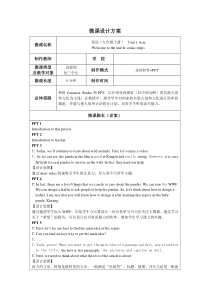 DOC
DOC
【文档说明】《Unit 1 Asia Welcome to the unit》教学设计8-九年级下册英语【牛津译林版】.doc,共(3)页,32.000 KB,由小喜鸽上传
转载请保留链接:https://www.ichengzhen.cn/view-102781.html
以下为本文档部分文字说明:
微课设计方案微课名称英语(九年级下册)Unit1AsiaWelcometotheunit&comicstrips制作教师学校微课类型及教学对象讲授型初三学生制作模式录屏软件+PPT微课长度8分钟制作时间总体思路利用Ca
mtasiaStudio和PPT,以介绍亚洲国家(以中国为例)的名胜古迹和文化为主线。在教授中,指导学生对国家的名胜古迹和文化进行简单的描述,并能与他人简单讨论旅行计划,培养学生听说读写能力。微课脚本(详案)PPT1Introductiontothisperiod.PPT2Introd
uctiontoteacher.PPT3T:Today,we’llcontinuetolearnaboutwildanimals.First,let’senjoyavideo.T:Aswecansee,thepan
dainthefilmisgoodatKungfuandreallystrong.However,itisverydifficultforrealpandastosurviveinthewild.Infact,theyneedou
rhelp.【设计意图】通过shortvideo快速吸引学生的注意力,导入到今天所学主题。PPT4T:Infact,therearealotofthingsthatwecandotocareaboutthepandas.WecanjointheWWF.Wecandesignaleaf
lettoaskpeopletohelpthepandas.So,let’sthinkabouthowtodesignaleaflet.Iamsurethatyouwillknowhowtodesignitafterlearn
ingthisreportonthebabypanda,Xiwang.【设计意图】通过邀请学生加入WWF,告知学生今天要设计一份宣传单号召人们关注大熊猫。通过学习关于“希望”的报告,可以设计出具有说服力的传单,增加学生学习课文的兴趣。PPT5T:First,l
et’stryourbesttofindthemainideaofthereport.T:Canyoufindaneasywaytogetthemainidea?S:…T:Yeah,great!Whenyouwanttogetth
emainideaofapassagequickly,payattentiontothetitle,thefirstorlastparagraph,thepicturesandcaptionaswell.T:Next,weneedtothinkaboutwhattherestofth
earticleisabout.【设计意图】西方的文章,特别是教材里的文章,一般都是“直线型”,标题、插图、开头与结尾一般就点明了文章的主旨大意,在读前指导学生快速浏览插图、开头与结尾,培养学生快速获取主旨大意的能力。PPT6T:Thereportisaboutthepandas,sol
et’sguessinwhataspectswecanintroducethepandas.Wewillusethemindmaptohelpus.Anyideasarewelcome.【设计意图】通
过思维导图,让学生以作者的身份去猜可能会写到大熊猫的哪些方面,读前预测可以激发学生阅读的兴趣。PPT7T:Iloveallyourideas.Now,let’sreadparagraphs2-5andfindtheirmainideastoseewhetheryouh
avemadetherightprediction.【设计意图】通过略读2-5段,寻找段落大意,对上一环节的猜测进行验证。PPT8T:Here,Ihaveaquestionforyou.Howdidyoufindthemainideaofparagr
aph4?Canyoucirclethetopicsentence?【设计意图】培养学生通过找主题句来确定主旨大意的阅读技能。PPT9T:Wehavealreadyknownthegistofthereportandthemainideasofeachparagrap
h.Itistimeforustofindouthowthereportisorganized.T:Aquestionforyou,howmanypartscanthereportbedividedinto?Whatarethey?【设计
意图】在明确文章主旨及各段落大意之后,通过小组讨论得出文章的主题结构,增强学生的篇章整体意识。PPT10T:Weknowthestructureofthereportandhowthereportisorganized.Now,let’sfindoutsomespecificinformati
onaboutthepandas.【设计意图】通过展示文章的思维导图,鼓励学生去寻找文章的细节信息。PPT11T:First,let’sfindoutwhatthepandaseatandhowmuchtheyweighindifferentstages.【设计意图】通过整合2、3两段
,让学生找出不同阶段大熊猫吃什么,重多少,训练学生的扫读能力。PPT12T:Whilelookingfortheanswers,youmayfindsomeusefulwordsthatcanhelpyouquicklyfindtheinformationy
ouneed.Pleasecirclethem.【设计意图】训练学生利用指示词去找具体的信息,训练学生扫读能力。PPT13T:Next,let’sfindoutwhatproblemsthepandasfaceandwhatactionw
ecantake.【设计意图】通过整合4、5两段,让学生找出熊猫面临什么样的危险以及可以采取的措施,训练学生的扫读能力。PPT14T:Whilelookingfortheanswers,youmayfindsomeusefulwordsthatcanhel
pyouquicklyfindtheinformationyouneed.Pleasecirclethem.【设计意图】训练学生利用指示词去找具体的信息,训练学生扫读能力。PPT15T:Sofar,wehaveabetterunderstandingofth
etext.Let’sreviewwhatweleantaboutthepandas.【设计意图】利用思维导图,让学生对文章整体进行清晰地了解,树立篇章概念。PPT16T:Weneedtotakeactiontohelpthemrightnow.Pleasedesignaleaflet
toaskpeopletocareaboutgiantpandas.【设计意图】要求学生完成刚开始设置的任务:制作宣传单,号召人们关注大熊猫,将所学的知识灵活运用,进行整体输出。PPT17T:Thinkabouthowyourleafle
twillbeorganizedandIwillprovideyouwithsomeusefulexpressions.【设计意图】提供必要的表达方式,让学生将本课时的重点词汇运用进去。PPT18T:Thankyouforwatching.设计理念与特色(微反思)
在本课设计中,教者从培养学生的整体篇章意识出发,利用思维导图帮助学生树立篇章概念,充分培养学生利用指示词快速寻找信息,训练学生的略读与扫读能力,中间穿插了部分阅读微技能的训练。专家点评
 辽公网安备 21102102000191号
辽公网安备 21102102000191号
 营业执照
营业执照